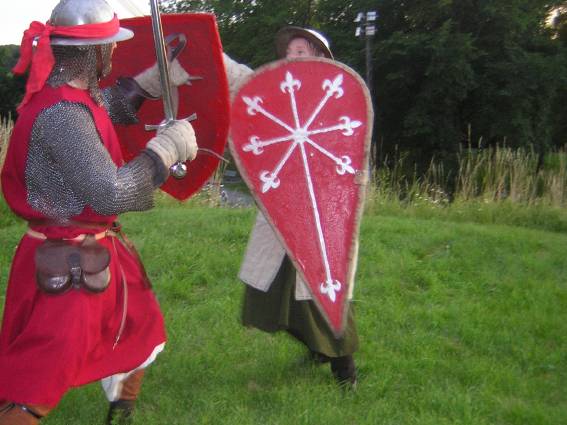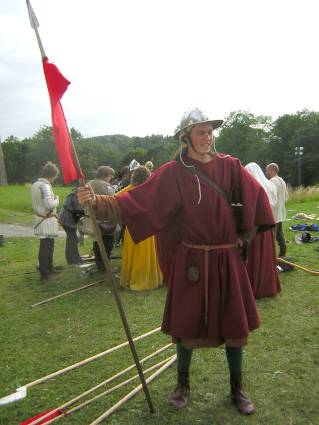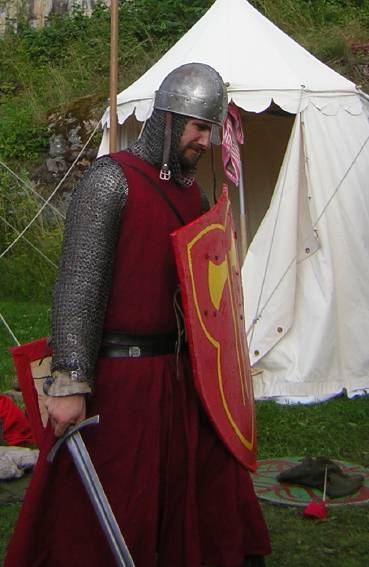I had not visited the event last year and was surprised by the sheer amount of people crammed into an at times limited space, according to peole in the know they had almost 4 times the number of paying visitors on the first day as there was at the same time last year and that's not counting kids below the age of 13 who get in for free.
Another (annoying) surprise was that the free entry deal for those clad in medieval costume had been dropped, Perhaps someone in charge has decied to try to maximize the profits or it can be a result of the fact that a the number of people in medieval costume has increased a lot over the years. Of course the quality&accuracy of the costumes are varied to say the least which might alos explain why the offer was dropped.
As an event itis for bettaer and for worse very much geared towards the visiting public and tourists, the craftsmen&women, medieval groups and merchants are basicly there as a form of entertainment together with the actual entertainers such as muscians and such. A lot of merchants are clearly there to make a buck by sellign what can be described as pesudo-medieval goods at best. It was possible to find slightly modifed surpluss leather goods from the Swedish army sold as medieval leather work sold only some dozen yards from teh stall of a real leather worker and so on. Stil one can find good deals on quality goods and then event is fun way to meet soem people with the same interests as one self even if we form a minority of the vistitors.
Below are some arms&armour related photos from the weekend taken by Daniel, a friend of mine, not myself.
GHFS, the Gothenburg Historical Fencing School demonstrated the art of German longsword fencing in Ringecks Blossfechten style in one part of the fortress. Workign alongside them in joint program was a Norwegian group which demonstrated the sword&buckler fencign found in the I:33 manuscript. Sadly i never got the name of the group but they were both impressive and interesting to watch. (The picture is too large to hotlink to so heres the link)
http://photobucket.com/albums/b282/Gentleman_...723013.jpg
Both groups did a great job of first verbaly explaining and then actualy demonstrating how medieval swords wera actualy used, contrary to the image proejcted by many movies and books. I spoke with several members of GHFS afterwards and got to handle the two Albion swords they had with them, a Squire Line Bastard Sword and a NG Regent :eek: a sword that size isn't supposed to feel and handle that way, oh wait it is :cool: ).
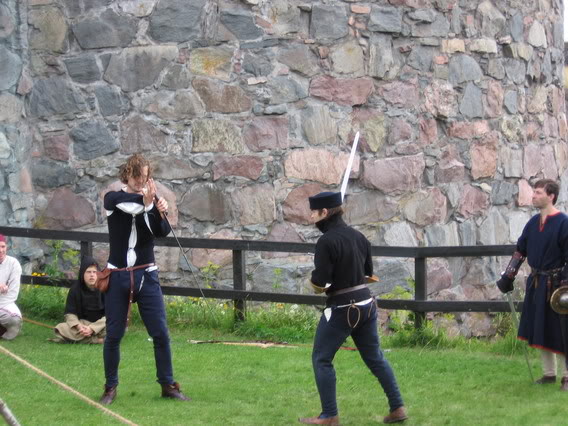
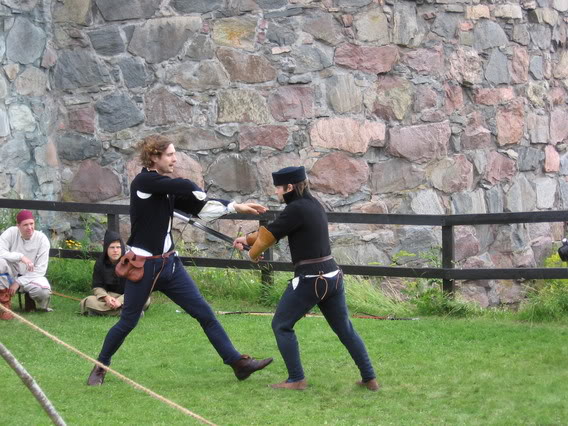
The men of "Albrechts Bössor" (lit 'Albrecht's Gonne's') portray handgunners from the late 14th Century and had a small sation set up wehre they demonstrated their arms and equipment. The "gonnes" are based on actual handguns found in Sweden&Germany. I got to fire one of the handsguns (powder only, no ball) and while the range could not have been anything to write home about the physical and psycological impact at close range must have been huge on troops not used to firearms. Small wonder that the hussites were able shatter superior numbers through the use of firearms and warwagons.

"Kompani Bastard" both preformed several funny medieval based plays and portrayed memebers of the Teutonic Order complete with visiting crusaders from the later part of the 14th Century. They held a couple of lectures and demonstrations on the Northern Crusades and on th eexperience of battle in the late 14th Century.
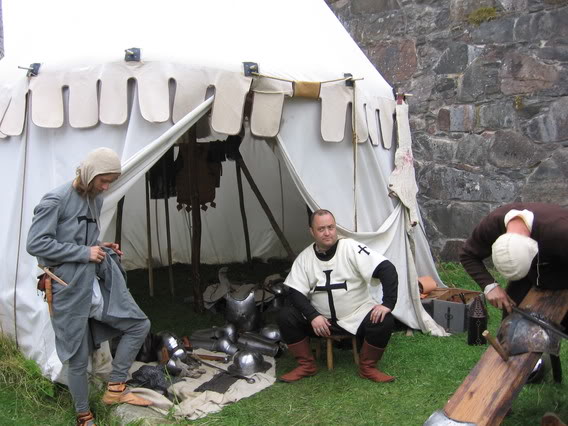
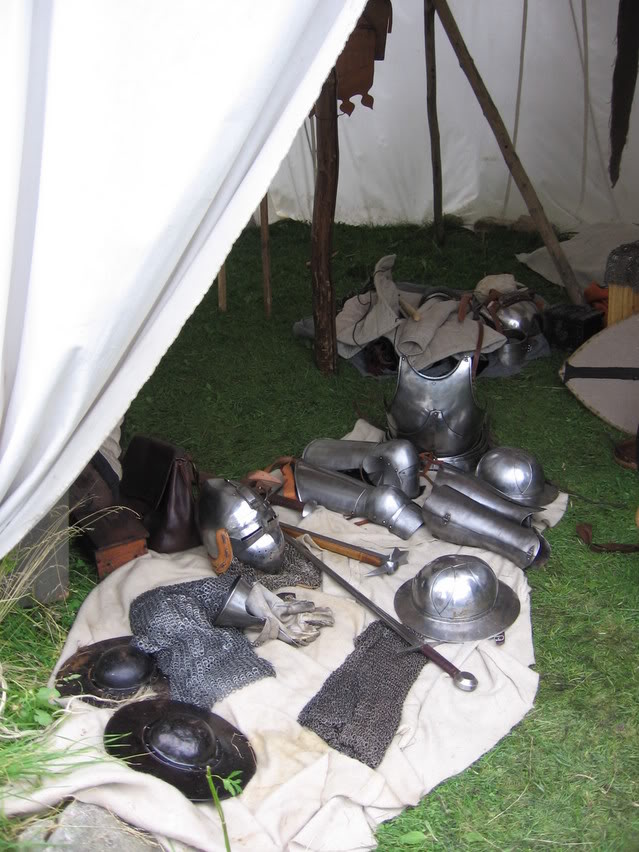
I never got to speak with these guys but the gear looked good from a distance, from other told me when i asked they were from Norway and called themselves "The Free Lancers"
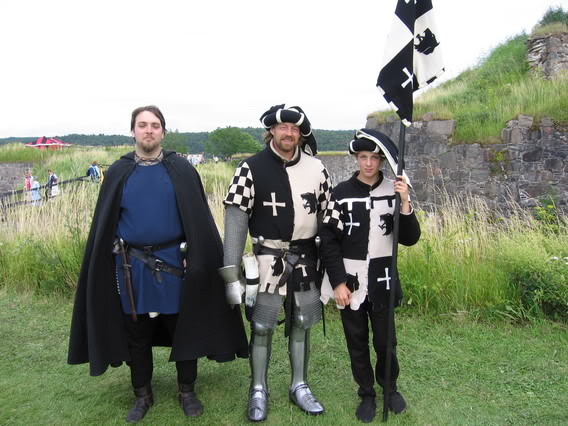
The official hompage of the event is availbale only in Swedish but you can find a photo gallery from the 2004 event here:
http://www.medeltidsdagarna.se/phpscripts/mg2...p;page=all
The Fortress of Bohus is located in what today is western Sweden but the area was part of Norway unitl 1658, it sits on an island which lies in the intersection of the rivers "Gota Elv" and "Nordre Elv" and effectively commands this important trade route. Upstream lies the town of Lödöse, today a small town but in the middle ages a bustling trade town (complete with a royal castle) which was one of the largest towns in Sweden.
Bohus is first documented in 1308 as wooden castle but it was soon converted into a large (for scandinavia) stone and brick castle which indicates the importance the castle had in the eye of the kings of Norway. In the late 16th Century the old and at the time rather war damaged castle was rebuilt into a modern renaissance fortress during a 20 year period of hectic building. The old medieval core was refurbished and surrouned by large bastions and outworks in the latest style.
addtional bastions, ravelins and outworks were built in the mid 17th Century as Norwegian military engineers strengthend the already strong fortress even more. The fortress recived it's final pre-ruin shape in the late 17th Century as the parts damaged in the last an very destructive siege was replaced by new defensive works and buildings. The fortress was decommissioned in 1789 and durign the next 100 years is suffered greatly as the locla population was allowed to take stoen and brick from it at will. This did irreparable damge to the once proud fortress and when preservation was begun in the last years of the 19th Century the site mostly resembled a huge pile of rubble. In 1926 proper restoration work was begun and 10 years of hard work laid the fundation to the site which can be seen today.
Durign it's active service Bohus was subjected to a least 15 sieges but it was never captured by force. Celebrated events include the infamous "Blast of Bohus" of 1566 in which an at first successfull Swedish assult was repulsed. The Swedes had managed to sieze the "Red Tower" which allowed the to contorll the castles water supply, a brave Norwegian soldier made his way into the powder magazine locate in the towers cellar and set fire to it. The resulting explosion destroyed the tower and killed some 250 Swedish soldiers entrenched in it. A norwegian counter-attack restablished the integrity of the defences and the dishartended Swedes abandoned the siege soon afterwards havign lost some 2300 to enemy action, disease and the weather. The event was considered so important that it is imortalised on the tomb of King Fredrick II as a relief.
The last siege took place in 1678 and was the most massive of them all, some 12.000 Nowegian, Danish and German soldiers laid siege to the fortress which was defended by 900 Swedes&Finns. During two months Bohus was pounded with a barrage of 30.000 cannon balls, 2265 mortar bombs, 384 stones, 161 heated round shot, 600 howitzer shells and 79 baskets each of illed with 13 handgrenades. Mines were dug into the outerworks , filled with gunpowder and detonated. Much of the fortress was reduced to rubble and at the end only 400 men remained fit for battle, the fortress was almost indefensible when a Swedish army arrived in the nick of time and forced the Norwegian commander to lift the siege.
The fortress today
http://www.precendo.se/pics/bohus/bo1_s.html
http://www.aerobilder.se/bhl_05.htm
http://www.boprod.se/davidsson/bo/kungalv_maj2003_3.html
